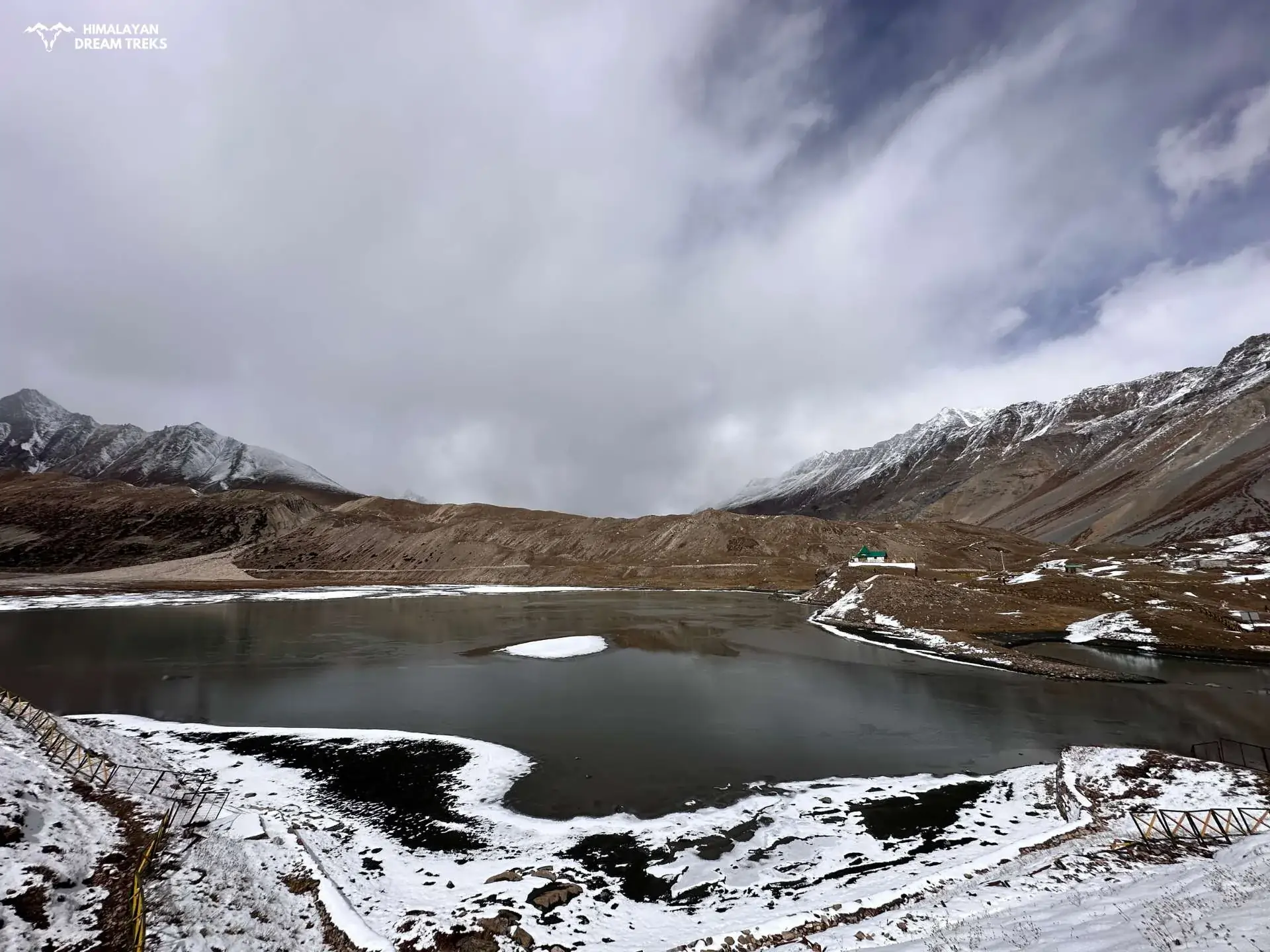Adi Kailash, also known as Chhota Kailash (little Kailash), is a mountain located in the Himalayan range in the Pithoragarh district of Uttarakhand, India. It is situated at a height of 5,945 meters above sea level.
Adi Kailash is considered a mirror image of Mount Kailash and a sacred site in Hinduism. It is believed to be the home of Lord Shiva, his partner Parvati, and their children Ganpati and Kartikey.

The mountain is a replica of Mount Kailash in Tibet and holds significant spiritual and cultural importance for Hindus.
It is considered the second among the “Panch Kailash,” five magnificent peaks across the Himalayas bearing the name “Kailash,” other being Mount Kailash in first place, Adi Kailash in second, Shikhar Kailash (Shrikhand Mahadev Kailash) in third, Kinnaur Kailash in fourth and Manimahesh Kailash in fifth place in terms of importance.
Table of Contents
Historical and Mythological Significance
Adi Kailash is associated with several mythical stories and legends from Hindu scriptures. According to the Puranas, Adi Kailash was the main stop of Lord Shiva’s marriage with Mata Parvati, originating from Kailash Mansarovar.
1. The Earthly Abode of Lord Shiva
Adi Kailash is believed to be the earthly home of Lord Shiva, the supreme deity in Hinduism. It is said that Lord Shiva meditated in this sacred region for thousands of years. According to the various mythical texts, Lord Shiva’s presence in Adi Kailash represents his unbreakable bond with Goddess Parvati and his divine form.
2. The Testing of Parvati’s Devotion
It is also believed that Adi Kailash is the site where Lord Shiva tested the devotion of Parvati, his partner. The story goes that Parvati, who was deeply in love with Lord Shiva, wanted to marry him. However, Lord Shiva was not interested in marriage and was focused on his spiritual pursuits.
Lord Shiva asked her to perform a series of complex tasks to test Parvati’s devotion. Parvati completed all the tasks, and Lord Shiva was impressed with her devotion. He then agreed to marry her, and they lived happily ever after.
3. The Panch Kailash
Panch Kailash, or the “Five Kailashas,” is the collective name for a group of five sacred mountain peaks in separate locations in the Himalayas, each of which is considered to be a manifestation of Lord Shiva. Adi Kailash is part of the Panch Kailash.
The five peaks are:
- Kailash Mansarovar
- Adi Kailash
- Shrikhand Mahadev Kailash
- Kinnaur Kailash
- Manimahesh Kailash.

4. Cosmic Dance and Divine Form
Adi Kailash is said to be the place where Lord Shiva performed his cosmic dance, known as the Tandava, and revealed his divine form to the Sage Ashtavakra.
The historical and mythological significance of Adi Kailash contributes to its spiritual importance, attracting followers from all over the world. The mountain is a symbol of spirituality and a place of deep devotion for Hindus, offering a profound connection with the god.
Geographical Significance
Adi Kailash’s geographical location near the India-Tibet border adds to its significance.
The height of Adi Kailash is about 5945 meters above sea level. The mountain is also known for changing its positions, which has been considered a primary attraction for pilgrims.
The terrain of Adi Kailash is challenging, requiring physical fitness and stamina, and the mountain’s natural beauty offers visitors a sense of calm and divinity.
Temples and Sacred sites located in Adi Kailash
The area is dotted with several temples and sacred sites, heightening its beauty. Some of the significant temples and sacred sites located in Adi Kailash are:
1. Adi Kailash Temple:
The Adi Kailash Temple is located at the center of the pilgrimage and is devoted to Lord Shiva. The temple is a significant site for devotees who undertake the Adi Kailash Yatra, seeking spiritual enlightenment and blessings from Lord Shiva.

2. Gauri Kund (Jolingkong Lake):
A lake exists at the bottom of this mighty peak known as Gauri Kund. Near its shoreline, a shrine of Goddess Parvati and Lord Shiva stands. Gauri Kund is a significant site for devotees who undertake the Adi Kailash Yatra, seeking spiritual enlightenment and blessings from Lord Shiva.
Location: situated at the foot of Adi Kailash, at an elevation of 5608 meters.
Story:
- Hindu Mythology: Named after Parvati, the wife of Lord Shiva, “Gauri Kund” translates to “Lake of Compassion.” Old scriptures narrate that after battling the fierce demon Jalandhar, Parvati sought refuge in this lake to regain her divine strength. The cleansing waters restored her power, allowing her to finish the demon.
- Local Folklore: Believed to be frequented by divine beings who descend from the heavens to bathe in its sacred waters.
Significance:
- Considered a vital stop during the Adi Kailash Yatra pilgrimage. Devotees take a holy dip in the lake, seeking purification and blessings.
- The natural beauty of the lake, reflecting the giant peak of Adi Kailash, creates a breathtaking view.

3. Om Parvat:
Om Parvat is a sacred mountain located near Adi Kailash. It is known for its unique shape and resembles the sacred Hindu symbol “Om.”
The mountain is 5590 meters above sea level and is considered a significant site for spiritual seekers and devotees who visit this place to experience its divine aura and deepen their spiritual connection with the god.
According to mythological beliefs, it is believed that there are a total of 8 mountains showing the Om symbol and only one is discovered till date, and that is ‘Om parvat.’ This significance makes it a historical and thrilling experience for visitors.

4. Parvati Sarovar:
Location: Situated 2 km from the peak of Adi Kailash, at an elevation of 4497 meters.
Story:
- Religious Importance: Regarded as a miniature version of Mansarovar Lake, which lies near Mount Kailash in Tibet. This association further cements the spiritual significance of Adi Kailash as a replica of the original “abode of the gods.”
- Local Legend: Said to have been blessed by Parvati herself, granting wishes and fostering spiritual growth.
Significance:
- Pilgrims bathe in the lake, believing it washes away sins and bestows good fortune.
- A shrine dedicated to Shiva and Parvati adorns the lakeshore, attracting devotees for prayers and offerings.
- Ancient Temple: An ancient temple located in Adi Kailash holds religious significance for locals and provides an opportunity for pilgrims to offer prayers and seek blessings.

Pilgrimage and Yatra
The history of the Adi Kailash Yatra is rooted in Hindu mythology. The Adi Kailash Yatra is a pilgrimage in which devotees go on to worship, carry out rituals, and connect with the divine energy that is present at the site.
The journey to Adi Kailash is a symbol of the eternal faith and the never-ending search for spiritual enlightenment that have been an inseparable part of Hindu tradition.
- The yatra starts in mid-May and lasts till mid-October, with the best time to visit from mid-May to June and September to mid-October.
- The newly constructed road Gunji-Lampiya Dhura Pass Road (GLDPR) has significantly reduced the Adi Kailash Yatra, making the pilgrimage more accessible and comfortable for most travelers.
- The construction of this motorable road has reduced travel time and fatigue, allowing pilgrims to reach their destination more easily and quickly.
- The road has reduced the trekking distance to Adi Kailash to only 4 km and provides a viewpoint from where the OM Parvat can be seen.
- It has made the Adi Kailash Yatra an attractive option for many devotees who wish to visit the sacred site.
The Adi Kailash Yatra offers several major attractions that add to the significance and beauty of the yatra. Some of the key attractions of the Adi Kailash Yatra include:
1. Adi Kailash Parikrama:
The main highlight of the Adi Kailash Yatra is the circumambulation (parikrama) of the sacred Adi Kailash mountain range.
2. Spiritual Pilgrimage:
Adi Kailash is considered a revered pilgrimage site for devout Hindus. It attracts numerous pilgrims who undertake the Adi Kailash Yatra to seek blessings, offer prayers, and experience spiritual upliftment.
3. Association with Epic Tales:
The Adi Kailash Yatra is associated with several mythical stories and legends from Hindu scriptures, further enhancing its spiritual and cultural importance.
Pilgrims and those seeking spiritual enlightenment from all walks of life continue to visit Adi Kailash.
In conclusion, Adi Kailash is a symbol of spirituality and a place of deep devotion for Hindus. The mountain’s association with Lord Shiva, its mythical stories, and its challenging terrain make it a popular pilgrimage destination for those seeking a profound connection with the divine.
Some Interesting Facts:
- The waters of Jolingkong Lake are believed to possess healing properties.
- Parvati Sarovar freezes over in winter, transforming into a stunning natural ice rink.
- Both lakes are considered vital for maintaining the ecological balance of the region.

Leave a Comment